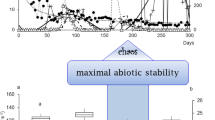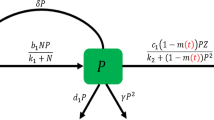Abstract
The dynamic behaviour of a model plankton community is described by solutions of a generalized predator‐prey model. The qualitative changes due to variations of parameters are considered and the existence of multistability and catastrophic behaviour is noted. Local and global bifurcations of the system are displayed. A seasonal variation of a parameter is introduced and the resulting dynamics are considered, such as quasiperiodic solutions or chaotic attractors.
Similar content being viewed by others
References
A.R. Champneys, Yu.A. Kuznetsov and B. Sandstede, A numerical toolbox for homoclinic bifurcation analysis, Appl. Nonlin. Math., Research Report Nr. 1.95, Department of Engineering Mathematics, University of Bristol (1995).
F. Doveri, M. Scheffer, S. Rinaldi, S. Muratori and Yu. Kuznetsov, Seasonality and chaos in a plankton-fish model, Theor. Pop. Biol. 43 (1993) 159–183.
M.J.R. Fasham, The statistical and mathematical analysis of plankton patchiness, Oceanogr. Mar. Biol. Ann. Rev. 16 (1978) 43–79.
P.J.S. Franks, J.S. Wroblewski and G.R. Flierl, Behaviour of a simple plankton model with food-level acclimation by herbivores, Mar. Biol. 91 (1986) 121–129.
S. Leibovich, Spatial aggregation arising from convective processes, in: Patch Dynamics, eds. S.A. Levin, T.M. Powell and J.H. Steele, Lecture Notes in Biomathematics, Vol. 96 (Springer, Berlin, 1993) pp. 110–124.
S.A. Levin and L.A. Segel, Hypothesis for origin of planktonic patchiness, Nature 259 (1976) 659.
D. Ludwig, D.D. Jones and C.S. Holling, Qualitative analysis of insect outbreak systems: the spruce budworm and forest, J. Anim. Ecol. 47 (1978) 315–332.
H. Malchow, Spatial patterning of interacting and dispersing populations, Mem. Fac. Sci. Kyoto Univ. (Ser. Biol.) 13 (1988) 83–100.
H. Malchow, Spatio-temporal pattern formation in nonlinear non-equilibrium plankton dynamics, Proc. R. Soc. Lond. B251 (1993) 103–109.
H. Malchow, Nonequilibrium structures in plankton dynamics, Ecol. Modelling 75/76 (1994) 123–134.
H. Malchow, Flow-and locomotion-induced pattern formation in nonlinear population dynamics, Ecol. Modelling 82 (1995) 257–264.
H. Malchow, Nonlinear plankton dynamics and pattern formation in an ecohydrodynamic model system, J. Mar. Syst. 7 (1996) 193–202.
H. Malchow and N. Shigesada, Nonequilibrium plankton community structures in an ecohydrodynamic model system, Nonlinear Processes in Geophysics 1 (1994) 3–11.
H. Matsuda, K. Kawasaki, N. Shigesada, E. Teramoto and L. Ricciardi, Switching effect on the stability of the prey-predator system with three trophic levels, J. Theor. Biol. 122 (1986) 251–262.
R.M. May, Predators that switch, Nature 269 (1977) 103–104.
R.M. May, Thresholds and breakpoints in ecosystems with a multiplicity of stable states, Nature 269 (1977) 471–477.
W.W. Murdoch and A. Oaten, Predation and population stability, Adv. Ecol. Res. 9 (1975) 1–131.
I. Noy-Meir, Stability of grazing systems: an application of predatorprey graphs, J. Ecol. 63 (1975) 459–483.
I. Noy-Meir, Theoretical dynamics of competitors under predation, Oecologia (Berl) 50 (1981) 277–284.
M. Pascual, Diffusion-induced chaos in a spatial predator-prey system, Proc. R. Soc. Lond. B251 (1993) 1–7.
T.J. Pedley and J.O. Kessler, Hydrodynamic phenomena in suspensions of swimming microorganisms, Annu. Rev. Fluid. Mech. 24 (1992) 313–358.
J.R. Platt, Bioconvection patterns in cultures of free-swimming organisms, Science 133 (1961) 1766–1767.
S. Rinaldi, S. Muratori and Yu. Kuznetsov, Multiple attractors, catastrophes and chaos in seasonally perturbed predator-prey communities, Bull. Math. Biol. 55 (1993) 15–35.
M.L. Rosenzweig, Paradox of enrichment: destabilization of exploitation ecosystems in ecological time, Science 171 (1971) 385–387.
A.B. Rovinsky and M. Menzinger, Chemical instability induced by a differential flow, Phys. Rev. Lett. 69 (1992) 1193–1196.
M. Scheffer, Fish and nutrients interplay determines algal biomass: a minimal model, OIKOS 62 (1991) 271–282.
L.A. Segel and J.L. Jackson, Dissipative structure: an explanation and an ecological example, J. Theor. Biol. 37 (1972) 545–559.
N. Shigesada and E. Teramoto, A consideration on the theory of environmental density, Jap. J. Ecol. 28 (1978) 1–8.
J.H. Steele, Some comments on plankton patches, in: Spatial Patterns in Plankton Communities, ed. J.H. Steele, NATIO Conf. Series IV Marine Sciences, Vol. 3 (Plenum Press, New York, 1978) pp. 1–20.
J.H. Steele and E.W. Henderson, A simple plankton model, Am. Nat. 117 (1981) 676–691.
J.H. Steele and E.W. Henderson, A simple model for plankton patchiness, J. Plankton Res. 14 (1992) 1397–1403.
E. Steffen and H. Malchow, Chaotic behaviour of a model plankton community in a heterogeneous environment, in: Selforganisation of Complex Structures, ed. F. Schweitzer, Vol. 2 (Gordon and Breach, London, 1996).
H. Stommel, Trajectories of small bodies sinking slowly through convection cells, J. Marine Res. 8 (1948) 24–29.
Yu.M. Svirezhev and D.O. Logofet, Stability of Biological Communities (Mir, Moscow, 1983).
M. Tansky, Switching effect in prey-predator system, J. Theor. Biol. 70 (1978) 263–271.
U. Timm and A. Okubo, Gyrotaxis: a plume model for self-focusing microorganisms, Bull. Math. Biol. 56 (1994) 187–206.
J.E. Truscott and J. Brindley, Ocean plankton populations as excitable media, Bull. Math. Biol. 56 (1994) 981–998.
J.E. Truscott and J. Brindley, Equilibria, stability and excitability in a general class of plankton population models, Phil. Trans. R. Soc. Lond. A347 (1994) 703–718.
A.M. Turing, On the chemical basis of morphogenesis, Phil. Trans. R. Soc. Lond. B237 (1952) 37–72.
S. Wiggins, Global Bifurcations and Chaos (Analytical Methods), Applied Mathematical Sciences, Vol. 73 (Springer,New York}, 198
S. Wiggins, Introduction to Applied Nonlinear Dynamical Systems and Chaos, Texts in Applied Mathematics, Vol. 2 (Springer, New York, 1990).
H. Winet and T. Jahn, On the origin of bioconvection fluid instabilities in Tetrahymena culture systems, Biorheology 9 (1972) 87–104.
C. Wissel, Theoretische Ökologie (Springer, Berlin, 1989).
J.S. Wroblewski and J.J. O'Brien, A spatial model of phytoplankton patchiness, Mar. Biol. 35 (1976) 161–175.
Author information
Authors and Affiliations
Rights and permissions
About this article
Cite this article
Steffen, E., Malchow, H. & Medvinsky, A.B. Effects of seasonal perturbations on a model plankton community. Environmental Modeling & Assessment 2, 43–48 (1997). https://doi.org/10.1023/A:1019096924487
Issue Date:
DOI: https://doi.org/10.1023/A:1019096924487




